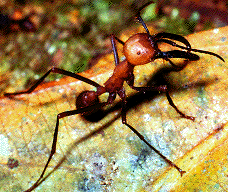|
B.S., Biology University of California, Los Angeles, 1988 Ph. D., Zoology, University of Texas at Austin, 1997 Behavioral and Population Ecology of the Army Ant Eciton burchelli  Foraging across Neotropical rainforest floors in swarms averaging six meters across, the army ant Eciton burchelli flushes creatures from the leaf litter into the waiting mouths of ant-following birds. Arthropods dismembered by the ants are carried back to the bivouac, a temporary nest made of their own living bodies. After foraging daily during the 14 day nomadic phase, bivouacs emigrate to new locations along the day's foraging trail. At the study site in Corcovado National Park, Costa Rica, probability of emigrating was halved in the wet season. Nomadic phases alternate with statary, when the colony stays in one site for 20 days and forages 65% of those days. Foraging directions in the statary phase are chosen randomly, not in a spiral pattern as previously reported. Swarm width and density of ants, a measure of foraging intensity, are negatively correlated, and statary swarms are significantly denser than nomadic swarms.
Foraging across Neotropical rainforest floors in swarms averaging six meters across, the army ant Eciton burchelli flushes creatures from the leaf litter into the waiting mouths of ant-following birds. Arthropods dismembered by the ants are carried back to the bivouac, a temporary nest made of their own living bodies. After foraging daily during the 14 day nomadic phase, bivouacs emigrate to new locations along the day's foraging trail. At the study site in Corcovado National Park, Costa Rica, probability of emigrating was halved in the wet season. Nomadic phases alternate with statary, when the colony stays in one site for 20 days and forages 65% of those days. Foraging directions in the statary phase are chosen randomly, not in a spiral pattern as previously reported. Swarm width and density of ants, a measure of foraging intensity, are negatively correlated, and statary swarms are significantly denser than nomadic swarms.
Foraging ants do not avoid old foraging trails of other colonies, but respond to contact with ants of another colony by initiating a rapid full retreat. Computer simulation models of colony foraging and interactions show that increasing collisions at higher densities decrease foraging efficiency. This density dependent interaction may serve to regulate population levels. At the density of colonies measured at Corcovado, 11 colonies/km2, simulations indicate a potentially significant impact on the prey base. Army ants are a patchy resource, providing unlimited food at the cost of tracking colonies in space and time. Dependent bird species memorize the locations of colonies and check their activity status each morning, following the first trail of ants encountered to the swarm. 7 of 45 species foraging with ants exhibit bivouac checking with 4 found at greater than 50% of swarms. Opportunistic species and some obligates locate swarms by following the calls of foraging birds. No differences in individual or species numbers were seen between statary and nomadic swarms, but two obligate species occurred in higher numbers at statary swarms. Significantly more birds and species foraged with wider swarms but no correlation with swarm density was observed, indicating competition for space is structuring bird attendance. Taught field ecology courses in Amazonian Peru for Evergreen College, Olympia, Washington, and in neotropical Ecuador for Boston University. E-mail mswartz@mail.utexas.edu or return to list of students |